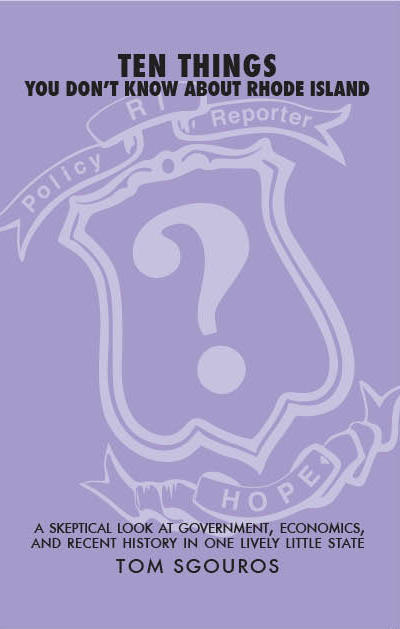What's this? A Book!
Or buy here: Light Publications, Powell's, or Bn, Amazon A look at the lousy situation Rhode Island is in, how we got here, and how we might be able to get out. Featuring
Now at bookstores near you, or buy it with the button above ($14, or $18 with shipping and sales tax). Contact information below if you'd like to schedule a book-related event, like a possibly entertaining talk on the book's subjects, featuring the famous mystery graph. Join the RIPR Mailing List! For a weekly column and (a few) other items of interest, click here or send an email to ripr-list-subscribe@whatcheer.net. RIPR is a (paper) newsletter and a weekly column appearing in ten of Rhode Island's finer newspapers. The goal is to look at local, state and federal policy issues that affect life here in the Ocean State, concentrating on action, not intentions or talk. If you'd like to help, please contribute an item, suggest an issue topic, or buy a subscription. If you can, buy two or three (subscribe here). Search this siteAvailable Back Issues:
Subscription information:
Contact:For those of you who can read english and understand it, the following is an email address you are welcome to use. If you are a web bot, we hope you can't understand it, and that's the point of writing it this way. editor at whatcheer dot net Archive:
AboutThe Rhode Island Policy Reporter is an independent news source that specializes in the technical issues of public policy that matter so much to all our lives, but that also tend not to be reported very well or even at all. The publication is owned and operated by Tom Sgouros, who has written all the text you'll find on this site, except for the articles with actual bylines. Responsibility: |
Thu, 30 Aug 2007
About time, too. But look what's in it:
- The sub-prime market meltdown: what's in store for us?
- Overvaluing another kind of asset: what some new discoveries mean for gene patents.
- Why photo ID laws for voting are worse than the disease they purport to cure.
- Review of Al Gore's new(ish) book: The Assault on Reason
Didn't you mean to subscribe by now?
23:25 - 30 Aug 2007 [/y7/au]
Random References for Issue 27 (coming real soon now)
- Intellectual Property Landscape of the Human Genome by Kyle Jensen and Fiona Murray, Science v310, 14 August 2005. Did you know that 20% of the human genome is patented?
- What is a gene, post-ENCODE? by Mark B. Gerstein, et al. Genome Research 17:669-681.
- Protecting the franchise, or restricting it? The effects of voter identification requirements on turnout, by Timothy Vercellotti and David Andersen, presented at the 2006 American Political Science Association meeting.
- Citizens Without Proof: A survey of Americans' possession of documentary proof of citizenship and photo identification, published by the Brennan Center for Justice at the NYU School of Law, November 2006
08:07 - 30 Aug 2007 [/y7/au]
Wed, 29 Aug 2007
See this rant. Sample quote:
I would happily pay for universal healthcare just so I never had to read an op-ed like this again. It's not that Williamson doesn't have a point, it's just that this beggar-thy-neighbor attitude is enough to make me retch, and I see it all the time. I don't get dental coverage, so why should grocery workers? My copay went up last year, so why shouldn't everyone else's? I don't pay for healthcare for my housecleaners, so why should I pay it for school cafeteria workers? Our wretched private healthcare system has turned us into a nation of spiteful and small-minded misanthropes.
20:43 - 29 Aug 2007 [/y7/au]
Tue, 28 Aug 2007
[Appeared last week in the RIMG newspapers, including the Woonsocket Call, Pawtucket Times, Kent County Times, and the rest.]
The Senate last week held hearings about some terrible things that happened in some of the state's foster homes. Some families and children were put in awful positions by what appear to have been poor choices by DCYF. But DCYF has been put in an awful position by poor choices made by our elected leaders. When you budget a disaster, should we be surprised when that's what we get?
Every spring the General Assembly debates the state's budget for the coming year, and every spring the House Finance Committee holds hearings on the different state departments. Advocates for the poor show up and beg not to have the services cut that provide crucial help to the state's poorest residents. The pleas fall on deaf ears, the services get cut, and the whole process is as predictable as the lengthening days in June.
This year, new fiscal controls have been put on the Department of Children, Youth and Families. These new restrictions were intended to keep the DCYF budget on a short leash by funding the department only three months at a time. In past years, DCYF has run out of its budget before the fiscal year was over, and to the state budget office and to the legislators of House Finance, this is a sign of irresponsible management. So this year, the DCYF Child Welfare budget was restricted, and the legislature withheld its funding until the end of each quarter. Demanding accountability is what strict fiscal management is all about, no?
Unfortunately, the new changes seem only to mean that DCYF will run out of money when the legislature isn't in session. So no one knows quite what to do. The Governor's staff believes this year's budget took away his authority to shift money over to the department, and is looking to House Finance to explain what ought to be done.
So what's the problem? Is it state workers demanding too much money, or is it state managers mismanaging the department?
Maybe it's neither. According to RI Kids Count, on the day Governor Carcieri was sworn in, in 2003, there were 2,564 children in "out-of-home" placements. This includes kids in foster care, in group homes, in hospitals and with relatives, all under DCYF supervision. At the time, there were 451 people in the department to look after them and the 5,700 other kids who didn't need that kind of service, at least not yet.
Four years later, the Governor is sworn in for his second term, and there are 3,311 children in out-of-home placement, and 6,100 other kids under DCYF supervision. This is a 15% jump just since last year, and a 29% jump since 2003. But the department staff was only up to 454, an increase of 0.7%. The latest addition? According to state budget documents, it was a junior member of the policy staff.
DCYF is not allowed to manage to its budget by only taking the children it can afford to take. In the face of skyrocketing demand for services to protect children whose situations are so bad that they can't stay in their homes, there is no reason to be surprised that the Child Welfare department couldn't stay within its budget. What's surprising is that the Governor and Assembly leadership refused to look beyond the numbers and figure out what was going on. They managed by the numbers and created a catastrophe.
Actually, it's not that surprising. Both the Governor and the Assembly leadership have an interest in maintaining the fiction that rising costs in our state government can only mean poor management. To admit that the state should spend more money on something would be to endanger their tax cuts. The passage of this year's budget saw an income tax cut that will save the top fraction of the top 1% of taxpayers -- half of whom don't even live here -- about $15 million in state taxes. The Assembly also stood by and refused to reinstate the tax on long-term capital gains, giving up another $20-30 million to the wealthiest taxpayers in the state, in the name of improving the state's economy. Economic development is important, but so is helping children who need our help.
While it's important that government be run efficiently, it's not true that costs can be cut year after year with no consequences. The hearings last week were a sign of a disaster no less real than the pictures from the Minneapolis bridge last month. Whether we need protection, or just a bridge that won't fall down, we all depend on our government. If we're going to have one at all, let's have one that's run well, not just one that's run cheap.
11:22 - 28 Aug 2007 [/y7/cols]
Beacon Mutual is in the news (still). The DBR report about their market conduct is pretty entertaining. I especially enjoyed the part about using company funds for "golf-related events" and spending hundreds of thousands of company dollars at pro shops. It seems their executives were treating themselves like, well, executives.
What's particularly funny about it is that all this was done while premiums were actually fairly low. See the Oregon ranking of workers' comp costs. This is a market that other insurance companies were abandoning because it wasn't profitable not so very long ago, and yet Beacon figured out a way not just to earn a profit, but to earn a scandalous profit from it. Puts insurance company kvetching in some perspective, doesn't it?
11:22 - 28 Aug 2007 [/y7/au]
[Appeared a couple of weeks ago in the RIMG papers.]
The awful news from Minnesota has brought to light a way in which Rhode Island leads the nation: we have a higher proportion of "structurally deficient" bridges than any other state in the nation. According to the Federal Highway Administration, 191 of our 753 bridges are considered deficient enough to need repair. As Kazem Farhoumand, the deputy chief engineer at DOT has been emphasizing in interview after interview, "'Structurally deficient' doesn't mean the bridge is unsafe to travel on." He's right, but it does mean they're on the way to being unsafe unless they get attention. There are 191 bridges in need of attention, and it's not clear when any of them will get it.
In my neighborhood in North Kingstown, there is a short bridge over a small body of water. Nine years ago, when I first paddled a canoe under that bridge, the girders holding it up were smeared with a thick layer of heavy grease, to protect it from rust. You couldn't reach up and touch the bridge without getting your hand coated with goo. But the grease has long since dried up and cracked, and rust now appears between those cracks. The concrete parts of the bridge structure are chipped and scaling and the metal parts are all rusted, though the rust on the railings is partly covered with a sloppy coat of paint applied a couple of years ago. They didn't paint the metal that holds the bridge up, just the railings.
Every few months, a different team of inspectors shows up to check out the bridge, but they (usually contractors from some out-of-state construction firm) never seem to know anything but "it's on the list" to be fixed. I'm reassured that someone seems to be monitoring the bridge's condition, but irritated that they never seem to do anything about it. Loss of lives isn't the only risk here. Not maintaining bridges has a dollar cost, too. We are currently replacing the Providence River bridge and planning to do the same with the Sakonnet River bridge, mainly because those bridges were not maintained properly. Together, that's almost a *billion* dollars in avoidable construction expenses.
The news isn't all bad. Two of our biggest bridges, the Pell bridge and Mount Hope, are just fine. The Mount Hope bridge has recently enjoyed a complete overhaul that involved replacing all its vertical cables, as well as unwrapping and lubricating the main cables. The Pell bridge has had recent inspections, and is looking forward to a $78 million paint job soon. What's the difference between these bridges and all the rest? Management.
The Pell and Mount Hope bridges aren't maintained by DOT, but by the RI Turnpike and Bridge Authority, an independent agency funded by bridge tolls. The Authority has a predictable income, which makes scheduling predictable maintenance work easy. DOT, on the other hand, relies on a combination of tax money and federal funding to do its work. Until recently, federal funding couldn't be used for maintenance, only for construction, and the rules still discourage it. This means that state tax revenue needs to cover maintenance, but also personnel expenses and debt service costs. DOT borrows every year to meet its expenses, like a candidate for credit counseling, so its debt service costs rise each year by a few million dollars. Health-care costs have increased a lot, too, as they have for everyone else. The result is that every year, there is less and less money available to take care of our bridges and roads.
In fact, there is so little money for maintenance that a few years ago, DOT redefined large stretches of road in South County, the East Bay and on Aquidneck Island as "approaches" to the Pell bridge, effectively making them the Bridge Authority's responsibility to repave. The most recent repaving of Route 1 in Wakefield was done with toll money from the Pell bridge.
DOT continues its borrowing, health care costs continue to rise, and the Governor continues to insist that the state can do everything we need done despite these pressures--and despite all the new tax cuts for the rich. This means that there is little prospect of DOT getting to do anything more than the inspection of those bridges. According to the FHWA, with 191 structurally deficient bridges we are in just about the same shape now as we were in 2000, when there were 187. I'd feel more comfortable with the Governor's bland assurances if there had been some movement on that list. At the moment, it seems unlikely that the situation at DOT will improve soon, so you might consider packing a life jacket in the car.
11:19 - 28 Aug 2007 [/y7/cols]
Sun, 05 Aug 2007
Check out the Federal Highway Administration's survey of bridge conditions. Fodder for the current discussions about the Minnesota disaster and risk assessment of our own states. For Rhode Island, notice that the number of "structurally deficient" bridges has remained pretty much constant since at least 2000. I guess we have the expert management of our business-executive governor to thank for that.
01:17 - 05 Aug 2007 [/y7/au]

